Mesembryanthemaceae
Family: Mesembryanthemaceae (Aizoaceae) Class: Dicotyledonae (Angiosperms) Order: Caryophyllales
Family:
Common names: mesembs, fig marigold, midday flower, ice plant (Eng.); vygie (Afr.)
Plant Attributes:
Plant Type:
SA Distribution:
Soil type:
Flowering season:
PH:
Flower colour:
Aspect:
Gardening skill:
Special Features:
Horticultural zones
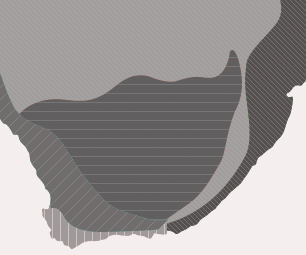
Jordaaniella dubia H.E.K.Hartmann and Jordaaniella anemoniflora (L.Bolus) Van Jaarv.
Family:
Common names: helder kruipvygie, matvygie (Afr.) Jordaaniella anemoniflora (L.Bolus) Van Jaarsv. [ = Cephalophyllum anemoniflorum (L.Bolus) N.E.Br. (Van Jaarsveld 2001)]
Plant Attributes:
Plant Type:
SA Distribution:
Soil type:
Flowering season:
PH:
Flower colour:
Aspect:
Gardening skill:
Special Features:
Horticultural zones

Gibbaeum (Haw.) N.E.Br.
Family:
Common names: mimicry plants (Eng.); volstruistone (ostrich toes), duimpie-snuif (thumb snuff), papegaaibek (parrot beak), vinger-en-duim (finger and thumb), visbekvygie (fishmouth vygie) and volstruiswater (ostrich water) (Afr.)
Species
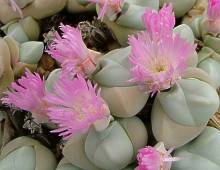
Gibbaeum album is a striking plant with leaves that are almost white and angular, mimicking the quartz pebbles in which it grows, forming compact clumps, 120 mm wide. Flowers have pink or white petals. This species is very restricted, occurring on the northern slopes of the Langeberg Mountains in an area smaller than 5 km².
Red List status: Critically Endangered, as it is threatened by road building, illegal harvesting for the specialist succulent horticulture trade and livestock trampling.
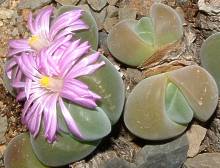
Gibbaeum dispar is a tiny plant up to 20 mm high. In cultivation or in favourable sites in the wild, plants may grow into clumps that are 120 mm wide. Each plant consists of short, woody stems with two unequal leaves at their ends. Leaves are velvety to the touch as they have minute hairs covering them. Flowers are solitary and an intense pink.
Red List status: Vulnerable, as it is restricted to a small area of the Little Karoo near Vanwyksdorp. It is potentially threatened by crop cultivation, mining, roadworks, harvesting for the specialist succulent horticulture trade, and livestock grazing and trampling.

Gibbaeum haaglenii is a low-tufted plant with pairs of leaves that are unequal in size. Old leaf pairs remain on the plant, pressing the growing stems outwards. Leaves are bluish grey-green and flowers are solitary with pink to lilac petals.
Red List status: Endangered, as it occurs only in the Lower Breede River Valley - on small quartz patches. Much of its habitat has been lost to wheat cultivation and remaining populations that occur on fragments between wheat fields are declining due to grazing and trampling by cattle and ostriches.
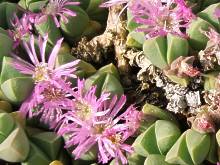
Gibbaeum petrense has sharp-edged, grey-green leaves, forming clumps of various sizes, between 50 and 100 mm wide and 20 to 50 mm tall. Its purple flowers are solitary. It occurs on the northern slopes of the Langeberg, growing in white quartz patches overlaying clay slopes. Its distribution is less than 10 km². In the past, it has lost habitat to road construction and is currently declining due to livestock trampling.
Red List status: Vulnerable.
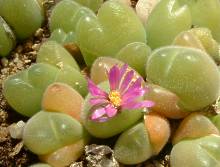
Gibbaeum pilosulum has rounded leaf pairs that grow embedded in the soil. Each leaf is tiny with a diameter of not more than 10 mm. Leaves are soft and fleshy and are covered in long white hairs. The flowers are solitary and are bright pink. It occurs near Touwsberg where it is declining due to trampling and grazing by livestock.
Red List status: Vulnerable.
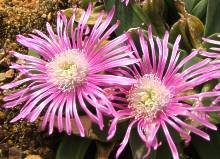
Gibbaeum schwantesii forms compact clumps, its boat-shaped leaf pairs are very unequal in size, the larger leaf being between 50 and 70 mm. The smaller leaf is only half the size of the larger leaf. Leaves are green to yellowish green and turn red at the edges. Flowers are typically white. This species occurs on the slopes of Langeberg in loamy renosterveld soils. It is known from two populations that occur within 1 km of each other. It is potentially threatened by soil erosion and trampling by livestock.
Red List status: Vulnerable.
Plant Attributes:
Plant Type:
SA Distribution:
Soil type:
Flowering season:
PH:
Flower colour:
Aspect:
Gardening skill:
Special Features:
Horticultural zones

Delosperma lydenburgense L.Bolus var. lydenburgense
Family:
Common names: Lydenburg vygie (Eng.); klipvygie, rotsvygie (Afr.)
Plant Attributes:
Plant Type:
SA Distribution:
Soil type:
Flowering season:
PH:
Flower colour:
Aspect:
Gardening skill:
Special Features:
Horticultural zones






Rate this article
Article well written and informative
Rate this plant
Is this an interesting plant?
Login to add your Comment
Back to topNot registered yet? Click here to register.